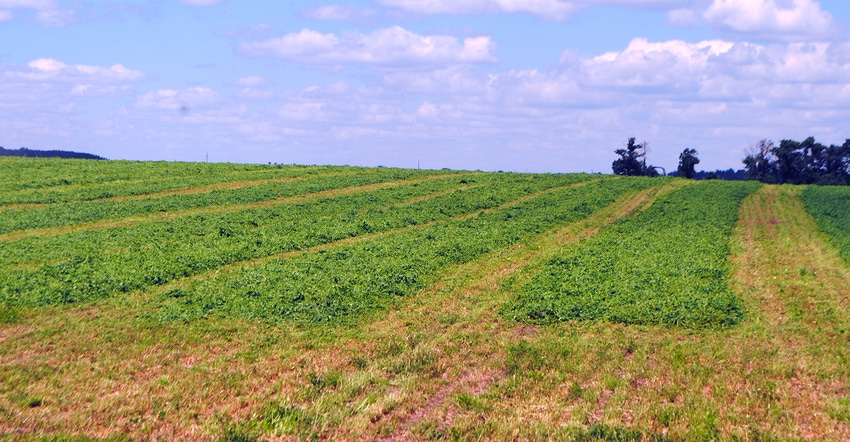
In a few short weeks, farmers across Wisconsin will begin harvesting first-crop alfalfa. To minimize breakdowns and speed up the harvest, get your equipment set up and ready.
Make sure your tractors, mowers, choppers, balers and trucks or chopper wagons are maintained and ready to go. And prepare your storage. Make sure you have the plastic for your bunkers and piles. Check to make sure you have ag bags and the bagger is prepared, or the silo unloaders are raised and working. These are things you can work on when it is raining so when it's time to get cutting, you are ready to go.
Dane County Extension crops and soils agent Heidi Johnson offers the following answers to these questions about harvesting alfalfa:
What percentage of total yield is contributed by the first cutting of alfalfa? How much does the first cutting decrease in feed value per day?
Johnson: Generally, about 40% of the total yield for the year is taken off in the first cut. Relative forage quality declines by about 4 points per day after it reaches its peak.
How do you know when alfalfa is ready to harvest? What if there are potato leafhoppers in the alfalfa?
Johnson: Dairy-quality hay should be harvested at 28 inches or bud stage. For other livestock, such as heifers or horses, it can be harvested at 32 inches.
Potato leafhoppers are only a problem on the second and third cuttings of alfalfa, because they migrate to Wisconsin from the south and do not arrive until late May. Because of the leafhopper’s small size and erratic movements, they are difficult to see in an alfalfa stand, so a sweep net should be used to assess hopper numbers. When leafhopper numbers in 10 sweeps exceed the alfalfa height in inches, growers should treat with an insecticide. If using a potato leafhopper-resistant alfalfa variety, the economic threshold for treatment is three times higher.
Should farmers stick to a 28-day cutting schedule throughout the growing season?
Johnson: In most years, for dairy-quality hay, alfalfa stands will reach the ideal cutting height or stage for the first time around May 20. Generally, after that, the stand will pretty consistently reach the bud stage, which is peak harvesttime, every 28 days. For farmers who are using the genetically modified low-lignin alfalfa, the cutting schedule can be drawn out to 35 days without sacrificing quality.
Get more INSIGHT: Download Hay Farming Basics now!
What is the proper moisture range for harvesting alfalfa for bags, piles and bunker silos? What about baleage and dry hay?
Johnson: Piles, bunkers and bags should all be put up at around 60% moisture, with a range from 55% to 65%. Baleage is typically put up a bit drier than in silos, but fermentation won’t occur if it is put up below 50% moisture. Dry bales are generally 12% to 16% moisture. Producers shouldn’t ensile hay when it is too wet, or nutrients will leach and clostridial fermentation may occur; it shouldn’t be put up too dry, or it won’t ferment well and can mold. Baled hay that is put up too wet can become heated and spontaneously combust.
Farmers usually harvest alfalfa after they have finished planting corn and soybeans. What if rain delayed planting? Should they plant soybeans or harvest alfalfa?
Johnson: This is a tough question because forage crops may differ in value among farms depending on land base, feedstocks and cost of production. But one way to look at this is to compare the average value of alfalfa to the average value of corn, and compare the losses you take by delaying either planting or harvest.
For dairy-quality hay, a producer will lose $1.25 to $1.50 for every lost point of relative feed quality, so if you delay harvest by four days at a loss of 4 points per day, that's a $20 to $24 loss per acre. For corn, the optimal planting date in southern Wisconsin is May 1. By May 10, growers are losing a half bushel per day in yield. If you use a corn price of $3.50 and delay planting by four days, this results in a loss of $7 per acre. So in this scenario, getting the alfalfa harvested makes more sense. But every farm needs to run these numbers for itself to make the best decision.
Why is it important to limit wheel traffic on alfalfa?
Johnson: Every time an alfalfa stand is driven on, stems are broken and yield potential is lost. Typical harvest operations to make dry hay with a 10-foot mower result in 146% of the field being driven over per cut.
Growers should also try to conduct their field operations as soon after cutting the alfalfa as possible. This is because progressively more damage is done to a stand the longer after harvest that wheel traffic occurs. Alfalfa immediately begins growing after harvest, and the larger the stems when broken, the greater the loss to the plant. A study in Arlington found that yield of the next alfalfa crop was reduced by an additional 6% for each day traffic was delayed. This article gives some tips for how to reduce wheel traffic and increase alfalfa yields.
About the Author(s)
You May Also Like






